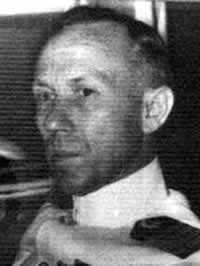Vernon Huber
| Vernon Huber | |
|---|---|
 | |
| 36th Governor of American Samoa | |
| In office April 22, 1947 – June 15, 1949 | |
| Preceded by | Harold Houser |
| Succeeded by | Thomas Francis Darden, Jr. |
| Personal details | |
| Born | August 28, 1899 Philadelphia, Illinois |
| Died | June 17, 1967 (aged 67) El Camino Hospital, Los Altos, California |
| Spouse(s) | Ida Brown |
| Alma mater | United States Naval Academy |
| Occupation | Naval officer |
| Military service | |
| Allegiance | |
| Service/branch | |
| Rank | |
| Commands | USS Livermore (DD-429) |
| Battles/wars | World War I World War II |
| Awards | Legion of Merit Navy Commendation Medal |
Vernon Huber (August 28, 1899 – June 17, 1967) was a United States Navy Rear admiral, and the 36th Governor of American Samoa from April 22, 1947 to June 15, 1949. He was born in Philadelphia, Illinois, and was appointed to the United States Naval Academy from that state. He served as the first commanding officer of the USS Livermore (DD-429) upon its launch in 1940. After his appointment, he advocated the diversification of the American Samoan economy. He also helped add to American Samoan self-government, and was the first governor to serve alongside a Samoan legislature, the American Samoa Fono.
Life
Huber was born on August 28, 1899 in Philadelphia, Illinois to parents Herbert Oliver and Nelle Davis Huber.[1] On December 27, 1927, he married Ida Brown.[1] Upon arriving at the El Camino Hospital in Los Altos, California on June 16, 1967, Huber was pronounced dead.[1]
Naval career
Huber was appointed to the United States Naval Academy on July 17, 1918.[2] He was the first commander of the USS Livermore (DD-429) upon its launch in 1940.[3]
Governorship
On August 22, 1947, Huber relieved Harold Houser and took the office of Governor of American Samoa.[1] His assistant governor was Ralph Ramey.[4]
He supported the opening of a cannery by famed aviator Harold Gatty, believing it would help diversify the American Samoan economy.[5]
During his term, the Samoans moved towards greater self-government. Under Huber's encouragement, the legislature of the territory, the American Samoa Fono, convened for the first time.[6] As governor, Huber maintained certain powers over the legislature, including the power of veto.[7] This reversed the previous position of Governor Otto Dowling, who had claimed an act of the United States Congress would be required to form a legislature.[6] He ceded the office to Thomas Francis Darden, Jr. on June 15, 1949.[1]
References
- ↑ 1.0 1.1 1.2 1.3 1.4 "Captain Vernon Huber". Governors. Government of American Samoa. 2010. Retrieved 17 May 2010.
- ↑ Register of the Commissioned and Warrant Officers of the United States Navy and Marine Corps and Reserve Officers on Active Duty. Washington, D.C.: United States Government Printing Office. 1920. p. 265. Retrieved 17 May 2010.
- ↑ Associated Press (8 October 1940). "New Destroyer Commissioned". The New York Times (New York City: The New York Times Company). p. 14.
- ↑ Korman, Seymour (20 February 1949). "In Samoa the People Now Rule Chiefs". Chicago Daily Tribune (Chicago, Illinois: Tribune Company). pp. 1–2.
- ↑ Lovelace, Douglas (2 August 1948). "Famed Flier Gatty Wants Fish Cannery". The Lewiston Daily Sun (Lewiston, Maine: Lewiston Daily Sun). p. 2. Retrieved 17 May 2010.
- ↑ 6.0 6.1 Sunia, Fofó Iosefa Fiti (1998). The Story of the Legislature of American Samoa. American Samoa: American Samoa Fono. p. 68. ISBN 982-9008-01-0. Retrieved 17 May 2010.
- ↑ Associated Press (15 September 1948). "Samoas to Get New Government". Kentucky New Era (Hopkinsville, Kentucky). p. 5. Retrieved 15 September 1948.
| ||||||||||||||||
